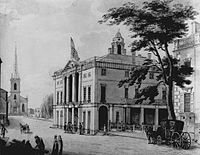19th New York State Legislature
| 19th New York State Legislature | |||||
|---|---|---|---|---|---|
|
|||||

The Old New York City Hall, where the Legislature first met in 1784. From January 1785 to August 1790, the Congress of the Confederation and the 1st United States Congress met here, and the building was renamed Federal Hall. From 1791 to 1793, and from 1795 to 1796, the State Legislature met again here. The building was demolished in 1812. (1798)
|
|||||
| Overview | |||||
| Jurisdiction | New York, United States | ||||
| Term | July 1, 1795 – June 30, 1796 | ||||
| Senate | |||||
| Members | 24 | ||||
| President | Lt. Gov. Stephen Van Rensselaer (Fed.) | ||||
| Party control | Federalist (14-9) | ||||
| Assembly | |||||
| Members | 70 | ||||
| Speaker | William North (Fed.) | ||||
| Party control | Federalist | ||||
| Sessions | |||||
|
|||||
| 1st | January 6, 1796 – April 11, 1796 |
|---|
The 19th New York State Legislature, consisting of the New York State Senate and the New York State Assembly, met from January 6 to April 11, 1796, during the first year of John Jay's governorship, in New York City.
Under the provisions of the New York Constitution of 1777, the State Senators were elected on general tickets in the senatorial districts, and were then divided into four classes. Six senators each drew lots for a term of 1, 2, 3 or 4 years and, beginning at the election in April 1778, every year six Senate seats came up for election to a four-year term. Assemblymen were elected countywide on general tickets to a one-year term, the whole assembly being renewed annually.
In March 1786, the Legislature enacted that future Legislatures meet on the first Tuesday of January of each year unless called earlier by the governor. No general meeting place was determined, leaving it to each Legislature to name the place where to reconvene, and if no place could be agreed upon, the Legislature should meet again where it adjourned.
On February 7, 1791, the Legislature had re-apportioned the Senate and Assembly districts, according to the figures of the 1790 United States Census.
Matthew Clarkson resigned, leaving a vacancy in the Southern District; and John Williams was elected to Congress, leaving a vacancy in the Eastern District.
At this time the politicians were divided into two opposing political parties: the Federalists and the Democratic-Republicans.
The State election was held from April 28 to 30, 1795. U.S. Chief Justice John Jay was elected Governor; and State Senator Stephen Van Rensselaer was elected Lieutenant Governor; both were Federalists.
Senators Samuel Jones, Joshua Sands (both Southern D.), Thomas Tillotson (Middle D.) and Philip Schuyler (Western D.) were re-elected. Abraham Schenck (Middle D.) and Ebenezer Russell (Eastern D.) were also elected to full terms in the Senate. Philip Livingston (Southern D.) and Ambrose Spencer (Eastern D.) were elected to fill the vacancies.
...
Wikipedia
